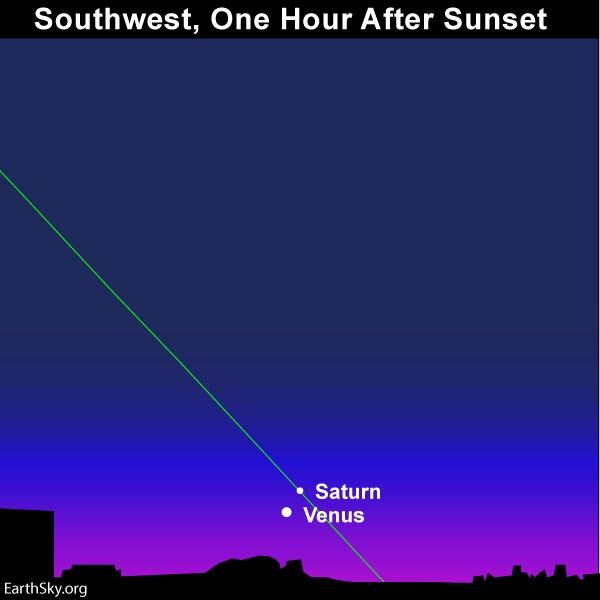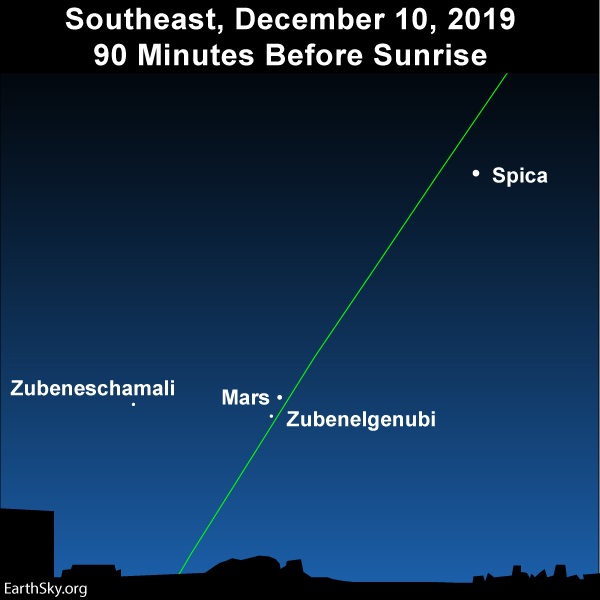
Yes, the dazzling conjunction of the brilliant planets Venus and Saturn at dusk/nightfall counts as this month’s marquee event, but let’s not forget about the less showy conjunction of two modestly-bright celestial lights – the red planet Mars and the star Zubenelgenubi – in the morning sky. Get up 1 1/2 hours (or more) before sunrise to view the close-knit morning couple lighting up the predawn darkness all this upcoming week. The conjunction happens on or near December 12, 2019.

There’s also a conjunction in the evening sky! In North America, Venus and Saturn have their conjunction on the evening of December 10, 2019. Read more.
For your convenience, we give you the approximate rising time of Mars for various latitudes (given an absolutely level and unobstructed horizon) for the next several days:
40 degrees north latitude
Mars rises 2 3/4 hours before the sunEquator (0 degrees latitude)
Mars rises 2 1/3 hours before the sun35 degrees south latitude
Mars rises 2 hours before the sunWant more specific information? Click here for a recommended sky almanac.
Mars and Zubenelgenubi, the constellation Libra’s alpha star, shine plenty close together on the sky’s dome all this upcoming week. In fact, the twosome will easily fit inside a single binocular field all the while. You can distinguish ruddy Mars from Zubenelgenubi, because Mars is the brighter of the two – better than twice as bright as Zubenelgenubi. However, both Mars and Zubenelgenubi are rather easy to see with the eye alone in a dark sky.

Look for fainter Zubenelgenubi above brighter Mars before dawn December 10, 2019.

Mars and Zubenelgenubi snuggle up together before dawn on December 12, 2019.

Look for Mars below Zubenelgenubi before dawn December 14, 2019.
Binoculars may come in handy, though. When the twosome first rises into your southeast sky, the extra thickness of Earth’s atmosphere near the horizon may blur or extinguish the view of the morning couple. Or, if you get up too late, the early morning twilight may wash them out. However, if you see Mars but not Zubenelgenubi, aim binoculars at Mars to reel Zubenelgenubi into visibility.
Even if you can spot both Mars and Zubenelgenubi with the unaided eye, you may still want to use binoculars to check out Zubenelgenubi. Binoculars reveal that Zubenelgenubi is double star – two stars in one. It is believed that these two stars are physically related, so Zubenelgenubi is probably a binary star – two stars revolving around a common center of mass.

Sky chart of the constellation Libra via IAU (International Astronomical Union). Each year, the sun passes in front of Libra from October 31 to November 23, and the sun has its annual conjunction with Zubenelgenubi on or near November 7. Zubenelgenubi is only about 1/3rd of a degree north of the ecliptic – the Earth’s orbital plane projected onto the constellations of the zodiac.
Want a sky chart showing the present position of Mars upon the zodiac? Click on this interactive sky chart via Heavens-Above.
Mars travels eastward in front of the constellation Libra the Scales all through December 2019. On December 10, 2019, Mars is heading in the direction of Zubenelgenubi; by December 14, 2019, Mars is definitely moving away from Zubenelgenubi. Midway between these dates – on or near December 12, 2019 – Mars passes a scant 1/5th of one degree to the north of Zubenelgenubi. (For reference, the width of your little finger at arm’s length spans about one degree of sky.)
This next week, before dawn, watch as the red planet Mars sweeps by Zubenelgenubi, the constellation Libra’s alpha star.
from EarthSky https://ift.tt/2LzIz88

Yes, the dazzling conjunction of the brilliant planets Venus and Saturn at dusk/nightfall counts as this month’s marquee event, but let’s not forget about the less showy conjunction of two modestly-bright celestial lights – the red planet Mars and the star Zubenelgenubi – in the morning sky. Get up 1 1/2 hours (or more) before sunrise to view the close-knit morning couple lighting up the predawn darkness all this upcoming week. The conjunction happens on or near December 12, 2019.

There’s also a conjunction in the evening sky! In North America, Venus and Saturn have their conjunction on the evening of December 10, 2019. Read more.
For your convenience, we give you the approximate rising time of Mars for various latitudes (given an absolutely level and unobstructed horizon) for the next several days:
40 degrees north latitude
Mars rises 2 3/4 hours before the sunEquator (0 degrees latitude)
Mars rises 2 1/3 hours before the sun35 degrees south latitude
Mars rises 2 hours before the sunWant more specific information? Click here for a recommended sky almanac.
Mars and Zubenelgenubi, the constellation Libra’s alpha star, shine plenty close together on the sky’s dome all this upcoming week. In fact, the twosome will easily fit inside a single binocular field all the while. You can distinguish ruddy Mars from Zubenelgenubi, because Mars is the brighter of the two – better than twice as bright as Zubenelgenubi. However, both Mars and Zubenelgenubi are rather easy to see with the eye alone in a dark sky.

Look for fainter Zubenelgenubi above brighter Mars before dawn December 10, 2019.

Mars and Zubenelgenubi snuggle up together before dawn on December 12, 2019.

Look for Mars below Zubenelgenubi before dawn December 14, 2019.
Binoculars may come in handy, though. When the twosome first rises into your southeast sky, the extra thickness of Earth’s atmosphere near the horizon may blur or extinguish the view of the morning couple. Or, if you get up too late, the early morning twilight may wash them out. However, if you see Mars but not Zubenelgenubi, aim binoculars at Mars to reel Zubenelgenubi into visibility.
Even if you can spot both Mars and Zubenelgenubi with the unaided eye, you may still want to use binoculars to check out Zubenelgenubi. Binoculars reveal that Zubenelgenubi is double star – two stars in one. It is believed that these two stars are physically related, so Zubenelgenubi is probably a binary star – two stars revolving around a common center of mass.

Sky chart of the constellation Libra via IAU (International Astronomical Union). Each year, the sun passes in front of Libra from October 31 to November 23, and the sun has its annual conjunction with Zubenelgenubi on or near November 7. Zubenelgenubi is only about 1/3rd of a degree north of the ecliptic – the Earth’s orbital plane projected onto the constellations of the zodiac.
Want a sky chart showing the present position of Mars upon the zodiac? Click on this interactive sky chart via Heavens-Above.
Mars travels eastward in front of the constellation Libra the Scales all through December 2019. On December 10, 2019, Mars is heading in the direction of Zubenelgenubi; by December 14, 2019, Mars is definitely moving away from Zubenelgenubi. Midway between these dates – on or near December 12, 2019 – Mars passes a scant 1/5th of one degree to the north of Zubenelgenubi. (For reference, the width of your little finger at arm’s length spans about one degree of sky.)
This next week, before dawn, watch as the red planet Mars sweeps by Zubenelgenubi, the constellation Libra’s alpha star.
from EarthSky https://ift.tt/2LzIz88

Aucun commentaire:
Enregistrer un commentaire